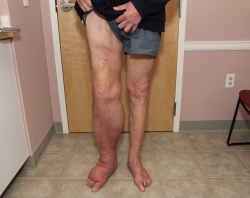Edema
Edema refers to the accumulation of interstitial fluid in any organ or area of the body which can cause swelling. This can be caused by either an increased secretion of fluid into the interstitium or impaired removal of this fluid.
Contents
Naturopathic Assessment
Causal Factors
In order to stimulate the innate ability of the body to heal the causes of disease must be identified and addressed. Edema is generally associated with other underlying conditions. It can also be caused by, or aggravated by lifestyle and environmental factors. A detailed assessment is required to determine which factors are contributing to edema.
Lifestyle
- Sedentary Lifestyle
- Sedentary lifestyles that involve little or no physical activity is associated with increased occurrence and risk of edema.
- Excessive salt intake can trigger edema by promoting retention of interstitial fluid. Increased alcohol intake can further exacerbate this condition.[1]
- Food intolerances may worsen edema.
Social
- Occupation
- Jobs that require standing or sitting for long periods of time can lead to peripheral edema.[2]
Environmental
- Allergies and insect bites can result in edema.
External
- Those that smoke are at increased risk of edema.
- Injuries
- Burns and other surgical procedures have been found to result in peripheral edema.[3]
Medical Interventions
- Prescription Medications
- Drugs such as Calcium channel blockers, Nonsteroidal anti-inflammatory drugs (NSAIDs), Estrogens/progesterones, Antihypertensive medication, Monoamine oxidase inhibitors, and direct vasodilators, to name a few, have been found to cause edema.[4]
Diagnostic Testing
In order to assess for edema and identify the possible causes, a healthcare practitioner will ask relevant questions regarding the patient's medical history, followed by a physical exam.[4]
- Blood tests including: electrolytes, albumin, kidney function tests, liver function tests, and tests to asses for heart disease.
- Other tests including echocardiography, ECG, Xrays, Ultrasound exams.
Related Symptoms and Conditions
Edema can be associated with a number of conditions such as[1]:
- Pregnancy
- Liver disease or Cirrhosis
- Kidney disease
- Venous insufficiency
- Varicose Veins
- Heart disease
- Type II Diabetes
- Hypothyroidism
- Abnormal removal of interstitial fluid and consequent edema can be caused by obstruction of the lymphatic system due to pressure caused by cancer or enlarged lymph nodes.[5]
Characteristics
The characteristics of edema include:[5]
- Swelling or puffiness of tissue directly under skin
- Stretched or shiny skin
- grey discolouration of the nail beds
Naturopathic Treatment
Home Care
Home care strategies include [6]:
- Dry skin brushing or stroking the affected area with a soft bristled brush in the direction towards the heart with firm, yet non-painful pressure.
- Wearing compression stockings, sleeves, or gloves to maintain the pressure on the limbs and to prevent fluid from collecting in the tissue.
- Elevating the affected area of the body above the level of the heart, and holding for a minimum of 30 minutes, 3-4 times a day.
Lifestyle
Lifestyle recommendations for the prevention and management of edema include:
- Regular exercise, such as walking, rebounding, yoga, Tai Chi or Qi Gong are beneficial in minimizing the extent of edema. When edema is present, especially in the limbs, it is important to use movement to assist in moving the fluid so that it doesn't pool in the extremities.
Naturopathic Therapies
The prescribing of naturopathic therapies requires the guidance of a naturopathic doctor as it depends on a number of factors including the causal factors, a person's age, prescription medications, other conditions and symptoms and overall health. It is always advisable to work with a naturopathic doctor prior to taking any natural therapies.
- Nutritional Foods include:[7]
- Herbs and spices that can assist with edema include: garlic
- Fruits such as coconut, grape, pineapple.
- Vegetables, Roots, Nuts & Gourds such as pumpkin, winter melon.
- Legumes such as broad (horse} bean, mung bean, castor bean, adzuki bean, kidney bean, black soybean.
- Grains such as barley, Job's tears.
- Meats such as beef, duck, chicken.
- Fish & Shellfish such as common carp, gold carp, saltwater clam.
- Other foods such as sea grass, hops, kelp, seaweed.
Naturopathic Therapies for edema include [1]:
- Clinical Nutritional Supplementation such as:
- Vitamins Vitamin B6 and Vitamin C
- Minerals such as Potassium
- Herbs such as Nettle (Urtica dioica), Horse Chestnut (Aesculus hippocastanum), Parsley|Parsley (Petroselinum crispum), Dandelion root (Taraxacum officinale), Hawthorn (Crataegus oxycantha), Bilberry (Vaccinium myrtillus), Purple coneflower (Echinacea purpurea)
- Gemmotherapies such as Equisetum arvense, Fraxinus excelsior, Juniperus communis, Ligustrum vulgare, Sambucus nigra
- Acupuncture can be very effective in the treatment of edema.
- Hydrotherapy, especially constitutional hydrotherapy, can be every effective in the treatment and management of edema.
References
- ↑ 1.0 1.1 1.2 Gaby Alan (2011) Nutritional Medicine, Fritz Perlberg Publishing, Concord, NH.
- ↑ Youmans John, Wells HS, Donley D, Miller DG. (1934) The effect of posture (standing) on the serum protein concentration and colloid osmotic pressure of blood from the foot in relation to the formation of edema. Department of Medicine and Physiology, Vanderbilt University School of Medicine, Nashville.
- ↑ Lund T, Onarheim H, Reed RK. (1992) Pathogenesis of edema formation in burn injuries, World Journal of Surgery;16(1):2-9.
- ↑ 4.0 4.1 Cho S, Atwood E. (2002) Review: Peripheral edema, American Journal of Medicine; 113:580-586.
- ↑ 5.0 5.1 Edema, Retrieved on June 27, 2013, from http://www.wikidoc.org/index.php/Edema
- ↑ Edema; Lifestyle and home remedies, Retrieved June 27, 2013 from http://www.mayoclinic.com/health/edema/DS01035/DSECTION=lifestyle-and-home-remedies.
- ↑ Lu Henry (1986) Chinese System of Food Cures, prevention and remedies Sterling Publishing Co. New York.
- ↑ Murphy, Robin (2005) Homeopathic Clinical Repertory, A Modern Alphabetical and Practical Repertory, Lotus Health Institute, Virginia.
